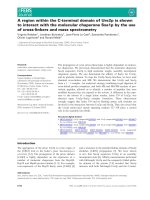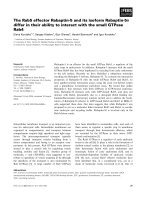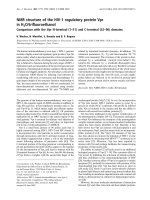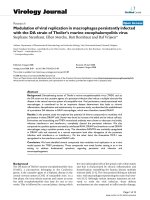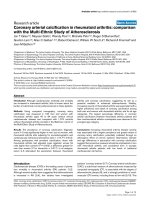Individual differences in relational motives interact with the political context to produce terrorism and terrorism support
Bạn đang xem bản rút gọn của tài liệu. Xem và tải ngay bản đầy đủ của tài liệu tại đây (305.2 KB, 10 trang )
Behavioral and Brain Sciences
Individual differences in relational motives
interact with the political context to produce
terrorism and terrorism-support
--Manuscript Draft--
Manuscript Number:
Full Title:
Individual differences in relational motives
interact with the political context to produce
terrorism and terrorism-support
Short Title:
Social dominance and group-based violence
Article Type:
Commentary Article
Corresponding Author:
Lotte Thomsen, Ph.D.
University of Oslo
Oslo, NORWAY
Corresponding Author Secondary
Information:
Corresponding Author's Institution:
University of Oslo
Corresponding Author's Secondary
Institution:
First Author:
Lotte Thomsen, Ph.D.
First Author Secondary Information:
Order of Authors:
Lotte Thomsen, Ph.D.
Milan Obaidi, MA
Jennifer Sheehy-Skeffington, MA
Nour Kteily, Ph.D.
Jim Sidanius, Ph.D.
Order of Authors Secondary Information:
Abstract:
The psychology of suicide terrorism involves more than simply the psychology of
suicide. Individual differences in Social Dominance Orientation (SDO) interact with
socio-structural, political context to produce support for group-based dominance
among members of both dominant and subordinate groups. This may help explain
why, in one specific context, some people commit and endorse terrorism, while others
do not
Powered by Edit orial Manager® and ProduXion Manager® from Aries Syst em s Corporat ion
Commentary Article
Click here to download Commentary Article: LankfordSubmitted.docx
LANKFORD
Abstract (59 words)
Main text (1000 words)
References (518 Words)
Entire text (1688 Words)
Individual differences in relational motives interact with the
political context to produce terrorism and terrorism-support
Lotte Thomsen
University of Oslo, University of Copenhagen, Harvard University
Milan Obaidi
European University Institute, Harvard University
Jennifer Sheehy-Skeffington
Harvard University
Nour Kteily
Harvard University
Jim Sidanius
Harvard University
LANKFORD
ADDRESSES:
Lotte Thomsen, Department of Psychology, University of Oslo, PO Box 1094
Blindern, 0317 Oslo, Norway. Phone +452530267. Email
URL:
/>Milan Obaidi, Department of Psychology, Harvard University, William James
Hall, 33 Kirkland Street, Cambridge, MA 02138. Email
Jennifer Sheehy-Skeffington, Department of Psychology, Harvard University,
William James Hall, 33 Kirkland Street, Cambridge, MA 02138. Email
, URL:
/>Nour Kteily, Department of Psychology, Harvard University, William James Hall,
33 Kirkland Street, Cambridge, MA 02138. Email , URL:
/>Jim Sidanius, Department of Psychology, Harvard University, William James
Hall, 33 Kirkland Street, Cambridge, MA 02138. Email
URL:
/>
1
LANKFORD
Abstract
The psychology of suicide terrorism involves more than simply the psychology of
suicide. Individual differences in Social Dominance Orientation (SDO) interact with
socio-structural, political context to produce support for group-based dominance
among members of both dominant and subordinate groups. This may help explain
why, in one specific context, some people commit and endorse terrorism, while
others do not.
2
LANKFORD
We agree with Lankford that one cannot understand suicide terrorism without
considering individual factors as well as contextual ones, and must distinguish
perpetrator from audience effects.
Nevertheless, while being willing to kill oneself is a necessary condition for carrying
out suicide bombings, this need not imply that what really drives suicide bombers,
rampage shooters and other self‐destructive killers is simply suicidality proper,
conveniently disguised as political terrorism in cultural and religious contexts that
ban individual suicide. In the case studies he uses to make the latter point, Lankford
not only seeks to estimate reliable predictors of suicide—such as prior suicide
attempts, expressed death wishes, and debilitating depression—but also includes
many soft risk factors such as the deaths of parents or siblings in childhood,
unemployment, divorce due to infertility, and even disciplinary problems in school.
Without knowing the base rates of both kinds of factors among the general
population, it is impossible to evaluate the degree to which they lead people to
commit suicide, let alone suicide terrorism, particularly when considered in the
often war-torn, occupied settings from which Lankford draws many cases.
Just as a suicidal mental condition is insufficient to drive suicide terrorism, so it may
likely be unnecessary. The case of Anders Behring Breivik—who shot 77 teenagers
at a political youth camp after seeking to blow up the Norwegian governmental
building—demonstrates the uncertainty of clinical judgments based on
interpretations of written or limited data records. Though Lankford concludes that
Breivik was clearly suicidal because his writings named the plight of conservative
3
LANKFORD
brothers and sisters being pushed toward suicide, and anticipated dying during
his terror mission, a final forensic-psychiatric assessment, following extensive
clinical interviews and 24-hour-observations, not only concluded that Breivik was
not psychotic, but found absolutely no evidence that he was suicidal (NTB, 2012).
Indeed, Breivik expressed fear of getting killed by the police upon being taken
captive.
What clearly is necessary for committing any such acts of terrorism is the
willingness to kill civilian others. We agree that this homicidal intent is likely fueled
by rage and that cultural and ideological endorsement facilitates suicide terrorism.
But both respond to the political reality in which a community finds itself. For
instance, Pape (2005) argues that suicide terrorist attacks in Lebanon ebbed and
flowed with the absence and presence of Israeli occupation (while suicidal intent
presumably remained fairly stable). Dismissing this as simply about increased
access to weapons and enemy targets ignores the role of the political context in
fueling rage towards an enemy group—relationally motivated, moral outrage (Rai &
Fiske, 2011) that they are subordinating, humiliating, discriminating, victimizing,
persecuting, and killing us, or threatening to do so, culminating in the intended
killing of perceived enemy civilians.
Such political context effects may play a role even in cases of remote identification
with group members suffering at times of conflict or oppression (SheehySkeffington, 2009). For instance, we recently found that support for a variety of
terrorism-related items among Muslim citizens living in Denmark, ranging from
4
LANKFORD
general understanding of terrorism to personal willingness to use violence to
defend Islam, was predicted by perceptions of general Muslim suffering, and was
mediated by the anger this suffering evoked (Obaidi, Thomsen, & Sidanius, 2013).
These victimization‐by‐proxy effects were even stronger among Danish-born than
foreign—born Muslims (Sidanius, Levin, Obaidi, Pratto, & Thomsen, 2013), and held
even when controlling for the effects of personal experiences of discrimination, a
structural factor indicated in radicalization among British Muslims (Travis, 2008).
In understanding how individual factors play into these processes, such that some
people in a specific context endorse or commit acts of terrorism while others in the
same context do not, we must go beyond the biographical and psycho-pathological
to the relational and ideological/political. The degrees to which people like, want
and seek relationships that are communal, hierarchical, or egalitarian underpin
many psychological phenomena (Thomsen, 2010). One particularly potent
dimension of relational motives is social dominance orientation (SDO)—the
motivation to create and maintain between‐group dominance hierarchies Pratto,
Sidanius, Stallworth, & Malle, 1994). Individuals high in SDO support hierarchical
intergroup structures, in which some groups dominate others, whereas individuals
low in SDO favor intergroup equality. These motives, and the cultural context that
embeds them, influence both the societal endorsement of suicide terrorism, and the
attitudes of those willing to commit it themselves. For instance, by looking at the
negative relationship between SDO and support for terrorism against the West
amongst Lebanese and Syrians, our work has demonstrated that counter-dominance
is an important ideological motivation undergirding support for terrorism against
5
LANKFORD
dominant groups (Levin, Henry, Pratto, & Sidanius, 2003; Henry, Sidanius, Levin, &
Pratto, 2005; Pratto, Sidanius, Bou-Zeinnedine, Kteily, & Levin, in press). Conversely,
among members of dominant majority groups in the West, the desire for groupbased dominance increases support for violence, wars of conquests, and terrorist
acts in retaliation against a threatening group or country (Thomsen, Green, &
Sidanius, 2008; Ho, Sidanius, Pratto, Levin, Thomsen, Kteily, & Sheehy-Skeffington,
2012). Further supporting the crucial interaction of individual, relational motives
and the structural context, the effect of group identification on terror support
among subordinate groups (e.g. of Arab identification among Lebanese) is
particularly strong among those who are low in SDO, whereas identification with
dominant groups (e.g. national identification among Americans) particularly
increases support for violence among those high in SDO (Levin et al, 2003; Kteily et
al, 2013; Thomsen, Green, & Sidanius,
. Again, Breivik’s self-described radical
identification with a Christian in-group and desire to preserve its dominance would
fit this picture.
In sum, we concur that it is crucial to consider both the person and the situation in
understanding suicide terrorism. Research and theory in the Social Dominance
tradition explicates how individual differences in relational motives interact
dynamically with the socio-structural context in shaping people’s attitudes towards
actions of group-based violence. Just as social psychology involves more than just
the situation, and individual differences more than just the psychopathological, so
the psychology of suicide terrorism is more than simply the psychology of suicide.
6
LANKFORD
References
Henry, P. J., Sidanius, J., Levin, S., & Pratto, F. (2005). Social dominance
orientation, authoritarianism, and support for intergroup violence between the
Middle East and America. Political Psychology, 26(4), 569-584.
Ho, A. K., Sidanius, J., Pratto, F., Levin, S., & Thomsen, L., Kteily, N., & SheehySkeffington (2012) Social Dominance Orientation: Revisiting the structure and
function of a variable predicting social and political attitudes. Personality and
Social Psychology Bulletin, 38, 583
Kteily, N. S., Sidanius, J., & Levin, S. (2011). Social dominance orientation: Cause
or “mere effect”? Evidence for SDO as a causal predictor of prejudice and
discrimination against ethnic and racial outgroups. Journal of Experimental
Social Psychology, 47, 208–214.
Kteily, N., Sidanius, J., Pratto, F., Levin, S., & Saab, R. (2013). Social dominance
orientation and group identification predict support for non- normative violence
in tandem. Manuscript in preparation.
Levin, S., Henry, P. J., Pratto, F., & Sidanius, J. (2003). Social dominance and social
identity in Lebanon: Implications for support of violence against the West. Group
Processes & Intergroup Relations, 6(4), 353-368.
NTB (2012). Breivik uten empati, men ikke psykotisk (Breivik without empathy, but
not psychotic). Available at />Obaidi, M., Thomsen, L. & Sidanius, J. (2013). I am ready to kill: The effects of
religious victimization and social dominance orientation on terror support among
Muslim immigrants living in Denmark. Manuscript in preparation.
Pratto, F., Sidanius, J., & Levin, S. (2006). Social dominance theory and the
dynamics of intergroup relations: Taking stock and looking forward. European
review of social psychology, 17(1), 271-320.
Pratto, F., Sidanius, J., Bou Zeinnedine, F., Kteily, N., & Levin, S. (in press).
When domestic politics and international relations intermesh: Subordinated
publics’ factional support within layered power structures. Foreign Policy
Analysis.
Sheehy-Skeffington, J. (2009). Social psychological motivations of suicide
terrorism: A community level perspective. Online proceedings of the 2009
Annual Scientific Meeting of the International Society for Political Psychology,
Dublin, Ireland.
Sidanius, J., Kteily, N. S., Sheehy-Skeffington, J., Ho, A. K., Sibley, C. & Duriez,
B. (2013). “You’re inferior and not worth our concern.” The reciprocal
7
LANKFORD
relationship between empathic concern and social dominance orientation.
Journal of Personality, 81, 313-323.
Sidanius, J., Levin, S.,Obaidi, M., Pratto, F., & Thomsen, L. (2013). Why do they
hate us so? Paper presented at the 36th Annuak Scientific Meeting of the
International Society of Political Psychology, Herzliya, Israel.
Thomsen, L. (2010). Seeing Social Relations. Doctoral Dissertation, Harvard
University.
Thomsen, L., Green, E., & Sidanius, J. (2008). We Will Hunt Them Down: How
social dominance Orientation and right-wing authoritarianism fuel ethnic
persecution of immigrants in fundamentally different ways. Journal of
Experimental Social Psychology, 44, 1455-1464.
Thomsen, L., Green, E.G.T., & Sidanius, J. (2013). Religion Hi-jacked: SDO interacts
with religious identification among Christians to predict willingness to persecute
assimilating Muslims. Manuscript in preparation.
Travis, A. (2008). MI5 report challenges views on terrorism in Britain. Available at:
/>
8

